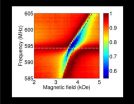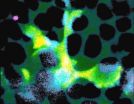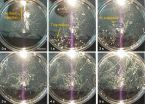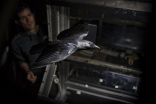(Press-News.org) This news release is available in Japanese.
Researchers at the Okinawa Institute of Science and Technology Graduate University (OIST) have identified a system that could store quantum information for longer times, which is critical for the future of quantum computing. This study was recently published in Physical Review Letters.
Quantum computing -- which aims to use particles on the atomic scale to make calculations and store the results -- has the potential to solve some key problems much faster than current computers.
To make quantum computing a reality, scientists must find a system that remains stable long enough to make the calculations. While this is an extremely short time frame, only thousandths of a second, the particles involved are so small that they are easily influenced by their surroundings. If the motion of the particles is disturbed, even a little, it throws off the whole calculation.
Nuclei are promising contenders for quantum memory because they are not easily influenced by their surroundings. However, that also makes them extremely difficult to manipulate. Many quantum physicists have tried with little success.
"In usual materials it is very difficult to control nuclei directly," said Prof. Denis Konstantinov, who runs the Quantum Dynamics Unit at OIST.
Instead of trying control the nucleus directly, the researchers focused on a "middle man" of sorts - the electrons orbiting the nucleus.
The nucleus has a tiny internal magnet, called a "magnetic moment," and the electrons orbiting around it also have magnetic moments that are about 1,000 times larger. Those magnets interact with each other, which is called the "hyperfine interaction."
The hyperfine interaction is stronger in some materials than others. The researchers found that a crystal made of manganese and some other elements has a strong hyperfine interaction. This enabled them to manipulate the nuclei by first targeting the electrons.
Information in quantum computing is conveyed by photons, which are individual particles of light, which also make up other nonvisible electromagnetic waves, such as ultraviolet and microwaves. The information transmitted is actually the quantum state of the photon. The quantum state of the photon needs to be transferred to another particle so it will last long enough for the computation to take place.
In this experiment, the researchers beamed microwaves through a manganese carbonate crystal. The magnetic field of the microwaves interacted with the magnetic moments of the electrons that are orbiting around the nuclei of the manganese atoms. The electrons' movements started to change, which in turn altered the movement of the nuclei because they are connected by the hyperfine interaction. The quantum state of the microwave photon was transferred to the nuclei when the nuclei's internal magnets flipped to point in the opposite direction.
This all has to happen very quickly before the quantum state of the photon changes. To transmit the information and flip the nuclei fast enough, there has to be a strong connection between the microwaves and nuclei via the electrons.
"To our knowledge, our experiment is the first demonstration of the strong coupling between microwave photons and nuclear spins," said Leonid Abdurakhimov, a post-doctoral scholar at OIST and first author of the paper.
Next, the team plans to cool down the system to nearly -273 C, or -500 F, to see if they can strengthen the connection and extend the time information can be stored by minimizing temperature fluctuations.
"We are making the first and important steps towards using an ensemble of nuclear spins for quantum memory," Konstantinov said. "We now have a whole class of materials that can be used for this purpose. Future experiments promise to be quite exciting."
INFORMATION:
(NEW YORK CITY - July 1, 2015) A novel synthetic hormone that makes certain skin cells produce more melanin significantly increases pain-free sun exposure in people with erythropoietic protoporphyria, a rare, genetic disorder resulting in excruciating pain within minutes of sun exposure. Two Phase III trials, conducted in Europe and in the United States by researchers at the Icahn School of Medicine at Mount Sinai and six other U.S. sites, showed that the duration of pain-free time in the sun and quality of life were significantly improved by treatment with afamelanotide, ...
Pregnancy and motherhood are both wonderful and worrisome times - could public health campaigns and social stereotypes be contributing to anxiety for mothers? Researchers from Monash University have identified links between perinatal anxiety and social and health messages that women are exposed to during the perinatal period, the period immediately before and after birth.
In a paper recently published in Women's Studies International Forum, Dr Heather Rowe and Professor Jane Fisher from the Jean Hailes Research Unit within the School of Public Health and Preventive Medicine ...
Unwanted, intrusive visual memories are a core feature of stress- and trauma-related clinical disorders such as posttraumatic stress disorder (PTSD), but they can also crop up in everyday life. New research shows that even once intrusive memories have been laid down, playing a visually-demanding computer game after reactivating the memories may reduce their occurrence over time.
The findings are published in Psychological Science, a journal of the Association for Psychological Science.
"This work is the first to our knowledge to show that a 'simple cognitive blockade' ...
Spider-like cells inside the brain, spinal cord and eye hunt for invaders, capturing and then devouring them. These cells, called microglia, often play a beneficial role by helping to clear trash and protect the central nervous system against infection. But a new study by researchers at the National Eye Institute (NEI) shows that they also accelerate damage wrought by blinding eye disorders, such as retinitis pigmentosa. NEI is part of the National Institutes of Health.
"These findings are important because they suggest that microglia may provide a target for entirely ...
A new method for calculating the exact time of death, even after as much as 10 days, has been developed by a group of researchers at the University of Salzburg.
Currently, there are no reliable ways to determine the time since death after approximately 36 hours. Initial results suggest that this method can be applied in forensics to estimate the time elapsed since death in humans.
By observing how muscle proteins and enzymes degrade in pigs, scientists at the University of Salzburg have developed a new way of estimating time since death that functions up to at least ...
When remembering something from our past, we often vividly re-experience the whole episode in which it occurred. New UCL research funded by the Medical Research Council and Wellcome Trust has now revealed how this might happen in the brain.
The study, published in Nature Communications, shows that when someone tries to remember one aspect of an event, such as who they met yesterday, the representation of the entire event can be reactivated in the brain, including incidental information such as where they were and what they did.
"When we recall a previous life event, ...
Classical Brownian motion theory was established over one hundred year ago, describing the stochastic collision behaviors between surrounding molecules. Recently, researchers from Technical Institute of Physics and Chemistry, Chinese Academy of Sciences discovered that the self-powered liquid metal motors in millimeter scale demonstrated similar Brownian like motion behaviors in alkaline solution. And the force comes from the hydrogen gas stream generated at the interface between liquid metal motor and its contacting substrate bottom.
Ever since the irregular motions ...
A group of the world's top doctors and scientists working in cardiology and preventive medicine have issued a call to action to tackle the global problem of deaths from non-communicable diseases (NCDs), such as heart problems, diabetes and cancer, through healthy lifestyle initiatives.
They say that identifying the enormous burden caused by NCDs is not enough and it is time for "all hands on deck" to pursue strategies both within and outside traditional healthcare systems that will succeed in promoting healthier lifestyles in order to prevent or delay health conditions ...
Sophia Antipolis, 02 July 2015: Patients are experiencing significant delays in access to approved cardiovascular devices due to bureaucratic inefficiencies, reveals a Devices White Paper from the Cardiovascular Round Table (CRT) published today in European Heart Journal.1
There is a clear correlation between declining death rates from cardiovascular disease and the introduction of innovative techniques and devices.1
The CRT is an independent forum established by the European Society of Cardiology (ESC) and comprised of cardiologists and representatives of the pharmaceutical, ...
Birds that moult at the wrong time of the year could be disadvantaged, according to a study by scientists at Lund University, Sweden. Birds depend on a full set of feathers for maximum efficiency when flying long distances, but the study shows that moulting has a detrimental effect on their flight performance.
The researchers trained a jackdaw to fly in a wind tunnel and measured different types of drag experienced by the bird. "We expected the bird not to be able to glide at the lowest speeds that it could glide at before moult and our results confirmed this", says ...





